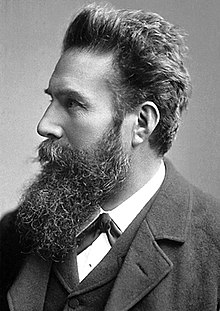Wilhelm Röntgen
Appearance

Wilhelm Conrad Röntgen (27 March 1845 – 10 February 1923) was a German physicist, who, on 8 November 1895, produced and detected electromagnetic radiation in a wavelength range today known as X-rays or Röntgen rays, an achievement that earned him the first Nobel Prize in Physics in 1901.
Quotes
[edit]
The New Marvel in Photography (1896)
[edit]
- Quotes of Röntgen from "The New Marvel in Photography", by H. J .W. Dam, in McClure's magazine, Vol. 6, No. 5 (April 1896), p. 416, from Project Gutenberg

- I was working with a Crookes tube covered by a shield of black cardboard. A piece of barium platino-cyanide paper lay on the bench there. I had been passing a current through the tube, and I noticed a peculiar black line across the paper. … The effect was one which could only be produced, in ordinary parlance, by the passage of light. No light could come from the tube, because the shield which covered it was impervious to any light known, even that of the electric arc. … I did not think; I investigated. I assumed that the effect must have come from the tube, since its character indicated that it could come from nowhere else. I tested it. In a few minutes there was no doubt about it. Rays were coming from the tube which had a luminescent effect upon the paper. I tried it successfully at greater and greater distances, even at two metres. It seemed at first a new kind of invisible light. It was clearly something new, something unrecorded.
- Having discovered the existence of a new kind of rays, I of course began to investigate what they would do. … It soon appeared from tests that the rays had penetrative power to a degree hitherto unknown. They penetrated paper, wood, and cloth with ease; and the thickness of the substance made no perceptible difference, within reasonable limits. … The rays passed through all the metals tested, with a facility varying, roughly speaking, with the density of the metal. These phenomena I have discussed carefully in my report to the Würzburg society, and you will find all the technical results therein stated.
- I am not a prophet, and I am opposed to prophesying. I am pursuing my investigations, and as fast as my results are verified I shall make them public.
Quotes about Röntgen
[edit]

- Röntgen retained the characteristic of a strikingly modest and reticent man. Throughout his life he retained his love of nature and outdoor occupations. Many vacations were spent at his summer home at Weilheim, at the foot of the Bavarian Alps, where he entertained his friends and went on many expeditions into the mountains. He was a great mountaineer and more than once got into dangerous situations. Amiable and courteous by nature, he was always understanding the views and difficulties of others. He was always shy of having an assistant, and preferred to work alone. Much of the apparatus he used was built by himself with great ingenuity and experimental skill.
- Röntgen has familiarized us with an order of vibrations of extreme minuteness compared with the smallest waves with which we have hitherto been acquainted, and of dimensions comparable with the distances between the centers of the atoms of which the material universe is built up; and there is no reason to suppose that we have here reached the limit of frequency.
- William Crookes, in his inaugural address as President of the British Association for the Advancement of Science, published in Nature No. 1506, Vol. 58 (8 September 1898), p. 438
- The lesson of the laboratory was eloquent. Compared, for instance, with the elaborate, expensive, and complete apparatus of, say, the University of London, or any of the great American Universities, it was bare and unassuming to a degree. It mutely said that in the great march of science it is the genius of the man, and not the perfection of the appliances, that breaks new territory in the great territory of the unknown. ...the discoverer himself had done so much with so little.
- H.J.W. Dam, "The New Marvel in Photography," McClure's Magazine 6:403 (April, 1896)
- Röntgen was an experimental physicist of the old school and built most of his own equipment. ...It was Rontgen's custom, when beginning new investigations, to repeat important experiments made previously by others in the same field. Since he was repeating Hertz' and Lenard's experiments with cathode rays, he used an armamentarium employed by those workers... he extended his experiments to include a Hittorf-Crookes' tube... when he discovered the new rays. The whole room was darkened... Röntgen suddenly saw a few brightly fluorescent crystals which lay on the table at some distance from the tube.
- Otto Glasser, Wilhelm Conrad Röntgen and the Early History of the Roentgen Rays (1934)
External links
[edit]- Biography at the official Nobel site
- Annotated bibliography for Wilhelm Rontgen from the Alsos Digital Library
- Wilhelm Conrad Röntgen Biography
- The Cathode Ray Tube site
- First X-ray Photogram
- Röntgen Rays: Memoirs by Röntgen, Stokes, and J.J. Thomson (circa 1899)
- Some places and memories related to Wilhelm Conrad Roentgen on Himetop – The History of Medicine Topographical Database
- The New Marvel in Photography, an article including an interview with Röntgen, in McClure's Magazine, Vol. 6, No. 5 (April 1896)
- Röntgen Memorial in Würzburg where he discovered the x-rays


